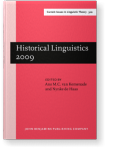Changes in the use of the Frisian quantifiers ea/oait “ever” between 1250 and 1800
This article presents an overview of the changes that took place in the syntactic use of the quantifiers ea and oait “ever” between 1250 and 1800 on the basis of the Frisian Language Corpus. Occurrences of Frisian ea and oait “ever” were classified and counted depending on the type of syntactic construction in which they were found. The constructions which were distinguished tend to correlate with the interpretation which the quantifier receives. This classification was performed for three main periods of the language: 1250–1550; 1550–1700; 1700–1800. It turns out that these periods saw some significant changes in the use of these quantifiers. Special attention is given to the peculiar behaviour of ea “ever” in relative clauses. It turns out that it displays properties both of free choice items and of negative polarity items. Furthermore, Frisian turns out to have been affected by language contact with Dutch at quite an early date, around 1700, when it borrowed oait to replace native ea. This change is analyzed as a case of reinforcement in the sense of Hopper & Traugott (2006). Our overall analysis supports a construction-specific analysis of changes in the use of quantifiers.
